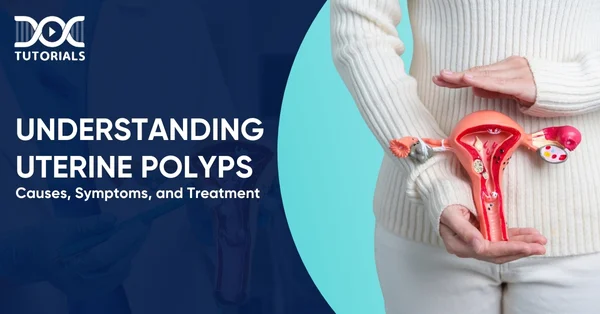Understanding Uterine Polyps| Causes, Symptoms, and Treatment

Uterine polyps are non-cancerous growths in the inner lining of the uterus, most commonly found in women in their 40s and 50s. It causes irregular periods, spotting between periods, and can even lead to infertility. Some cases of uterine polyps can be asymptomatic, and they can cause major issues if left untreated. Thus, it is essential for both NEET PG aspirants and healthcare professionals to know how to recognise, diagnose, and manage this medical condition.
Keep reading for comprehensive insight!
What is a Polyp in Uterus?
Uterine polyps, also known as endometrial polyps, are growths which develop in the endometrium, which is the inner lining of the uterus. These growths are caused by an overgrowth of endometrial tissue and can attach to the uterine wall through a thin stalk or a broad base.
They can be any shape—round or oval—and any size. Some are as small as a sesame seed and others as big as a golf ball. Additionally, it’s possible that the patient can have a single polyp or multiple at once.
What Causes Uterine Polyps?
While the exact cause of polyps in uterus is unknown, several factors are known to contribute to their development. They are as follows:
- Hormonal Imbalance: When oestrogen is higher than progesterone, the endometrial lining can thicken excessively and lead to the formation of polyps.
- Excess Oestrogen Exposure: Oestrogen stimulates the uterine lining to build up each month. Repeated or prolonged exposure to high oestrogen levels increases the risk of abnormal tissue growth, which can turn into polyps.
- Chronic Inflammation: Ongoing irritation or inflammation of the uterine lining—often due to infections or other medical conditions—can disrupt normal cell renewal. This can result in abnormal tissue growth, including polyps.
- Genetic and Hormonal Conditions: Women with hormone-related disorders like Polycystic Ovarian Syndrome (PCOS) or those with a family history of uterine polyps are more likely to develop them due to inherited or hormonal predispositions.
What are the Symptoms of Polyps in Uterus?
Here’s a breakdown of the common endometrial polyp symptoms:
- Irregular Periods: Uterine polyps are the main cause of irregular periods. Periods come early or late and vary in length and flow.
- Heavy Menstrual Bleeding: Also known as Menorrhagia, this is a medical condition characterised by heavy menstrual bleeding. If not managed early, it can lead to fatigue or anaemia.
- Bleeding Between Periods: Spotting or bleeding between cycles—intermenstrual bleeding—is a common sign of polyps in uterus.
- Postmenopausal Bleeding: Vaginal bleeding after menopause is one of the biggest red flags and usually requires further investigation.
- Bleeding After Intercourse: Some women notice spotting or bleeding after sex, which can be due to a polyp in uterus.
- Infertility: Polyps in uterus can interfere with embryo implantation or disrupt the uterine environment, making it harder to conceive or carry a pregnancy to term.
- Mild Pelvic Discomfort: Large polyps can sometimes cause a dull ache in the lower abdomen, but this is rare.
Recognising these symptoms of polyps in uterus early can help in timely diagnosis and treatment, especially for those managing fertility or postmenopausal health.
How is a Uterine Polyp Diagnosed?
Diagnosing a uterus polyp involves imaging, direct visual inspection, and tissue sampling. The goal is to see if there’s an abnormal growth and rule out cancer. Here’s how it works:
- Transvaginal Ultrasound – A thin, wand-like device is inserted into the vagina to create images of the uterus using sound waves. It shows any thickened endometrial tissue or visible polyps. This is usually the first step.
- Sonohysterography (Saline Infusion Sonogram) – If the ultrasound is unclear, saline is injected into the uterus through a thin tube. This expands the uterine cavity and allows for clearer ultrasound images and detection of small or hidden polyps.
- Hysteroscopy – A hysteroscope—a thin, flexible tube with a camera and light—is inserted through the cervix to view inside the uterus. It confirms the polyp and can also guide surgical removal during the same procedure.
- Endometrial Biopsy – A soft suction tool collects tissue samples from the uterine lining. These are examined under the microscope to see if there are abnormal cells. However, biopsies may miss polyps if the sample doesn’t include them.
- Curettage – In some cases, a curette—a small looped surgical tool—is used to scrape the uterine lining and remove polyps or tissue. The material is sent to the lab to check for cancer or precancerous changes.
Each of these diagnostic procedures will help determine if polyps are present and if they are benign or need further attention.
What are the Treatment Options for Uterine Polyps?
Treatment for uterine polyps depends on size, symptoms, and risk factors. Some polyps may not need immediate action, while others may need medical or surgical intervention. Here are the options:
- Observation
Small, symptom-free polyps may not need treatment, especially if there’s no increased risk of uterine cancer. These often resolve on their own and are monitored over time with follow-ups.
- Medication
Hormonal therapy with progestins or gonadotropin-releasing hormone (GnRH) agonists can help control symptoms like irregular bleeding. These medications work by regulating hormone levels, but only give short-term relief. Symptoms may come back once the medication is stopped.
- Surgical Removal (Uterine Polypectomy)
Hysteroscopy is one of the most efficient methods to remove uterine polyps. A hysteroscope (a thin, lighted instrument) allows real-time visual guidance and complete removal of the polyp.
Removed tissue is sent for pathological examination to check for cancer or precancerous changes. About 5% of uterine polyps are cancerous, so lab analysis is crucial.
What are the Risk Factors for Uterine Polyps?
Several health and hormonal factors can increase your chances of developing uterine polyps. While the exact cause is not always clear, some conditions and medications are more common in people who develop them. Key risk factors include:
- Age and Hormonal Stage
Perimenopausal and postmenopausal women are more likely to develop uterine polyps due to hormonal fluctuations.
- Obesity and Overweight
A BMI between 25 and 30 (overweight) or above 30 (obese) means more oestrogen in the body, which can encourage polyp growth.
- High Blood Pressure (Hypertension)
People with chronic hypertension are at higher risk, although the connection is not fully understood.
- Tamoxifen Use
Taking tamoxifen, a breast cancer medication, increases your chances of developing uterine polyps.
- Hormone Replacement Therapy (HRT)
Oestrogen-based HRT, especially when taken in high doses without progesterone, can increase endometrial changes, including polyps.
- Inherited Genetic Conditions
Rare conditions like Lynch syndrome and Cowden syndrome are known to increase the risk of abnormal growths in the uterus, including polyps.
How to Prevent Polyps in Uterus?
Uterine polyps can’t be prevented entirely, but early detection is key to avoiding complications and managing symptoms. Here’s what you can do:
- Regular gynaecological checkups are the key to spotting polyps before they become a problem.
- Keep yourself healthy to balance your hormones naturally.
- Manage hormonal conditions like PCOS through proper medical care.
- Limit use of oestrogen-containing medications unless prescribed and monitored by a doctor.
Regular screenings and checkups will allow your healthcare provider to detect uterine polyps early. This leads to early treatment and better outcomes, so regular visits are a must for women’s reproductive health.
FAQs About Uterine Polyps
- Is uterine polyp removal painful?
Before the procedure, the doctor will give the patient medication to numb the pain. They might feel some mild tugging or pressure, but it shouldn’t hurt.
- What causes uterine polyps?
The reason is unknown, but oestrogen probably promotes their growth. Risk factors are high blood pressure and obesity.
- What is the best treatment for uterine polyps?
Surgery to remove the polyps is the best treatment. Hormonal meds can help with symptoms, but only provide temporary relief.
- Can uterine polyps be prevented?
No, you can’t prevent them. But regular gynaecological check-ups help catch polyps early and prevent complications.
- Can uterine polyps be removed naturally?
While natural removal isn’t possible, a healthy diet that reduces inflammation and balances hormones can help manage symptoms. Focus on unprocessed foods, like fruits, veggies, whole grains, and lean proteins.
Conclusion
Uterine polyps are common but can cause a lot of problems, from abnormal bleeding and infertility to postmenopausal complications. Though the exact cause is not always known, hormonal imbalances, inflammation, and genetics are linked to it. Early diagnosis and treatment are key to preventing long-term complications and protecting reproductive health.
If you are a medical student, DocTutorials offers a vast repository of topics, high-quality video lectures, question banks, test series, expert advice, and more to help with your exam preparation. Check out our NEET PG courses today!
Latest Blogs
-
-

NEET SS Exam 2024: Analysis, Key Dates, Counselling
The NEET SS 2024 exam kicked off on March 29, 2025. Over two days and two slots, candidates across 13…
-

NEET PG Registration 2025: An Essential Guide For Exam Prep
The NEET PG registration, which is conducted online, is a crucial step in the exam process. Filling out the NEET…





